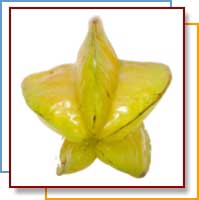
The star fruit or carambola is a tropical fruit that is gaining
popularity in the United States. This fruit acquired its name from the
five pointed star shape when cut across the middle of the fruit. It has a
waxy, golden yellow to green color skin with a complicated flavor
combination that includes plums, pineapples, and lemons.
|
|
Star Fruit |
Serving size
1/2 cup sliced, raw (54g)
|
Amounts
Per Serving |
% Daily
Value |
| Calories
20 |
|
| Calories
from Fat 0 |
|
| Total Fat 0g |
0% |
| Saturated
Fat 0g |
0% |
| Cholesterol
0mg |
0% |
| Sodium 0mg |
0% |
| Total
Carbohydrate 4g |
1% |
|
Dietary Fiber 1g |
4% |
|
Sugars 3g |
|
| Protein 0g |
|
| Vitamin A |
0% |
| Vitamin C |
20% |
| Calcium |
0% |
| Iron |
0% |
* Percent Daily Values are based on a
2,000 calorie diet. |
|
| |
|
Originally from Sri Lanka and the Moluccas, and cultivated in Southeast
Asia and Malaysia for several hundred years, this fruit also goes by many
other names including: bilimbi, belimbing, Chinese star fruit, five-angled
fruit and the star apple. Today, star fruit flourishes in south Florida
and Hawaii because the fruit thrives on growing in a warm environment. Two
types of star fruit are grown, tart and sweet. Tart varieties typically
have narrowly spaced ribs, while sweet varieties tend to have thick,
fleshy ribs. The tastes between the two are hardly distinguishable, as the
tart variety still has some sweetness. This tropical fruit is readily
available July through February.
Star fruits are an excellent source of vitamin C, is low fat, and
naturally sodium and cholesterol free. A small whole star fruit will
provide approximately 2/3 cup sliced.
Select firm, shiny skinned, even colored fruit. Star fruits will ripen
at room temperature and have lightly brown edges on the ribs when it’s
ripe. Avoid purchasing star fruit with brown, shriveled ribs. This
delicious fruit is also available dried.
Non-ripe star fruit should be turned often, until they are yellow in
color and ripe with light brown ribs. Store ripe star fruits at room
temperature for two to three days or unwashed, and refrigerated, in a
plastic bag for up to one week.
Star fruits are great to eat out of hand as these tropical delights do
not need to be peeled or seeded before eating. Simply wash the fruit, remove
any blemished areas, cut crosswise to get the star shape, and eat!
Recipes
 Star
Fruit Salad Star
Fruit Salad
Makes 4 servings
Each serving equals 1 cup of fruit or vegetables
Source: Produce for Better Health
Ingredients
2 star fruit
2 kiwis
2 bananas
1 cup mango fruit nectar
1 cup low fat vanilla yogurt
Peel kiwi and banana, cut into medium size pieces. Slice star fruit
into ¼-inch thickness. Combine all fruits in bowl. Add nectar over
mixture. Refrigerate for 3 hours. Top with vanilla yogurt.
Nutritional analysis per serving: Calories 201, Protein 5g, Fat
2g, Calories From Fat 7%, Cholesterol 3mg, Carbohydrates 46g, Fiber 6g,
Sodium 46mg.
Find more in our
recipe database!
|



